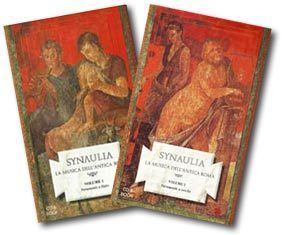Active from 1995 | Genre Early music | |
 | ||
Similar Walter Maioli, Aktuala, Corde Oblique, Sineterra, Mesomedes | ||
Ancient roman music synaulia i
Synaulia is a team of musicians, archeologists, paleorganologists and choreographers dedicated to the application of their historical research to ancient music and dance, in particular to the ancient Etruscan and Roman periods.
Contents
- Ancient roman music synaulia i
- Ancient roman music synaulia vi
- History
- The archeological musical research work
- Scientific collaborations
- Discography
- Filmography
- Songs
- References

Ancient roman music synaulia vi
History

The name comes from the Greek synaulia, which in ancient Rome referred to a group of instruments consisting mainly of wind instruments.

The group was founded and at first sponsored by the Rijksmuseum van Oudheden in Leiden, Netherlands in 1995 by Italian paleorganologist Walter Maioli and choreographer and anthropologist Natalie Van Ravenstein.

In the beginning the Synaulia’s main task was mainly educational: the reconstruction of ancient musical instruments for the Dutch archeological center, Archeon. Later the scope was widened to include a more profound study into Italy’s music and dance focusing primarily on ancient Rome. The fruits of Synaulia’s intensive study were used as material for films, serials and documentaries about ancient Rome (among them Gladiator by Ridley Scott and the television series Rome), the use of the instruments for scholastic purposes, as well as in the publication of numerous articles on the subject.
The archeological-musical research work

In the absence of a system of musical notation for the period in question, the reconstruction and study of ancient musical expression was based on comparative studies of iconography, textual analysis, social studies and customs, also drawing from paleorganology, ethnomusicology, archeology and historiography.

The richness of the iconographic documentation, the abundance of tested theories and numerous literary connections facilitated the study and reproduction of a wide range of antique musical instruments, helping to determine, among other points of interest, their melodic and harmonic possibilities and acoustic quality.
Armed with this historical information, the group’s research was then subdivided into several main research branches. The first branch was dedicated to wind instruments. The research led to the reconstruction of instruments such as syrinx, fistulae, tibiae, cornu, tuba, bucina, iynx, and rhombus. The second branch dealt with string instruments: among others the lyra, cithara, sambuca, cordae and pandura were reconstructed.
The Greeks and Romans did not invent string instruments, but rather improved and created variations on the existing ones. The first mentions of antique string instruments such as zithers, lyres and harps were documented in the area from the Nile to Mesopotamia around 3000 BC. The lyre in particular had an essential role in Greek-Roman life. The Greek lyre was a strongly symbolic instrument made of tortoise shell (representing the intermediate life between Sky and Earth), a piece of stretched leather (a symbol of sacrifice) and two horns to which the cords were affixed (representing the celestial Bull). This instrument represented a symbolic altar, uniting Sky with Earth. In many representations other instruments often accompany the string instruments. The most common duo is the lyrae et citarae drawn together by the Pan flute. Other frequently represented combinations are stringed instruments and tibiae, double instruments with reed and double flutes with the tympanum and other percussion instruments. The third branch was dedicated to percussion, and work was undertaken to reconstruct the tympanum, cymbal, scabillum, sistrum, rasum and other celebrated instruments from the late imperial period, the so-called “Golden Age” (aurea aetas).
Scientific collaborations
Other collaborators as consultants and collaborators of the project are Nathalie van Ravenstein, Luce Maioli, Ivan Gibellini, Anna Maria Liberati (Museo della Civiltà Romana, Maurizio Pellegrini (Museo Nazionale Etrusco di Villa Giulia, Rome) Romolo Staccioli e Maria Grazia Iodice (Università La Sapienza, Rome), Paola Elisabetta Simeoni (Museo Nazionale delle Arti e Tradizioni Popolari), Maria Grazia Siliato, Marcus Junkelmann Ratzennhofen (Germany), Carlo Merlo (Clesis, Rome), Magdi Kenawy (Accademia d’Egitto, Rome), Werner Hilgers (Rheinisches Landesmuseum Bonn, Germany), il H.P. Kuhnen (Rheinisches Landesmuseum, Trier Germany), Maria Paola Guidobaldi (Sovrintendenza di Pompei), Febo Guizzi (Milan), Gerard Ijzereef (Amsterdam) e Fabrizio Felice Ridolfi (Rome).
Discography
Filmography
Compositions of Synaulia, Music of Ancient Rome vol. I and vol. II were used in soundtracks of documentaries and films, like:
Songs
LudusMusic from Ancient Rome - Volume 2: String Instruments · 2002
Magna MaterMusic from Ancient Rome - Volume 1: Wind Instruments · 1996
PavorMusic from Ancient Rome - Volume 1: Wind Instruments · 1996
